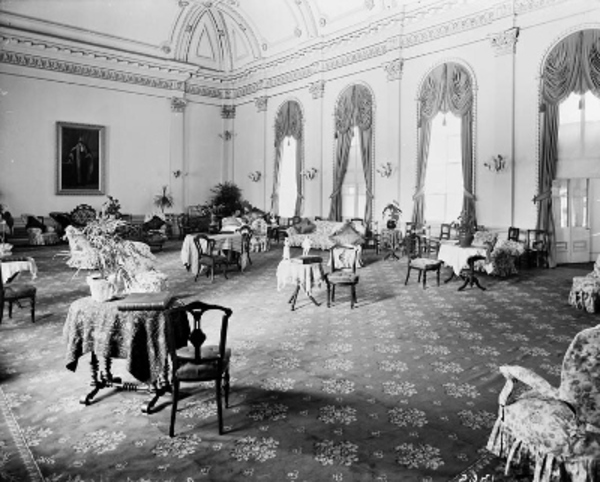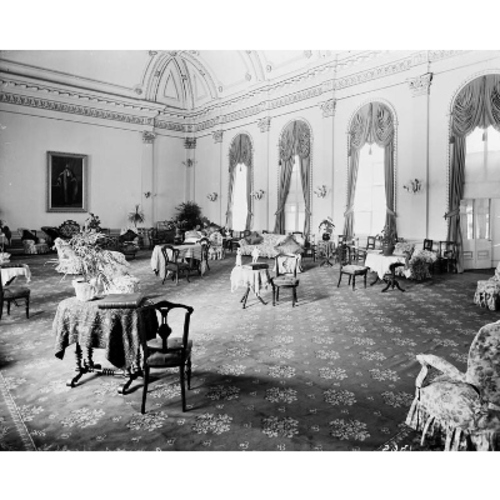
Source: Link
JACQUES, JOHN, cabinet-maker, furniture manufacturer, and financier; b. 9 Nov. 1804, probably in the county of Cumberland, England, son of Thomas Jacques; m. Mary Quinton (1808–95), and they had one son and one daughter; d. 14 Feb. 1886 in Toronto, Ont.
John Jacques is believed to have apprenticed in cabinet-making at Wigton (Cumbria), England, and he spent some years at his trade in London. In 1831 he immigrated to York (Toronto) and worked as a cabinet-maker first for Elisha Benjamin Gilbert and later for William Maxwell. Jacques entered into partnership with Robert Hay to buy Maxwell’s business in 1835. Their firm, Jacques and Hay, was to set the pace for furniture manufacturing in the Canadas for the following half century.
Jacques and Hay produced in much greater quantity than their rivals, but they also led in quality. Pioneers in mass production techniques in the Upper Canadian furniture industry, they catered to the constant demands of immigrants with functional, machine-worked furniture in pine and basswood. They also served many middle class people and tended the needs of the wealthy leaders of taste who had first supported their venture. Their products were of considerable significance in the development of what might be called a southern Ontario furniture style in the middle decades of the 19th century. Firms such as Jacques and Hay, it is true, had to follow successive international fashions in Empire, Gothic, Rococo, and Eastlake styles, but into these fashions Jacques and Hay particularly blended the element of the regional style and thus perpetuated it. The principal characteristics of this regional variation on a general North American theme were solidity, a virtual absence of veneer, the large use of black walnut, and ornamentation which though it reflected the fussiness of the age never reached the point of vulgarity; the finished product bore a high gloss.
By the 1840s Jacques and Hay and other early Upper Canadian cabinet-makers had weaned many of the élite away from a dependence on imported furniture, although such customers in Montreal clung tenaciously to imports from Britain and the United States. Mahogany and rosewood were still thought to be materials of quality in Montreal, but in Canada West walnut, abundant in the region and virtually absent in Canada East, and to a lesser extent other native hardwoods such as maple and oak, were raised in status. Jacques and Hay were assisted in Canada West by the antipathy of many members of their upper class clientele to American products and by the costs of transporting bulky items from Britain.
Patrons of Jacques and Hay for their first-class work included leaders in public life and business in Canada West, and they supplied some of the finest institutional furnishings of their time. Sword’s Hotel and Osgoode Hall in Toronto, and Rideau Hall in Ottawa, were fitted with the firm’s best products. Like most of the leading makers of quality cabinetware, Jacques and Hay exhibited frequently and their winning of prizes in local, provincial, and international competitions further enhanced their reputation. Descriptions of their craftsmanship in exhibition pieces suggest a high degree of skill and taste; furthermore, extant pieces of their furniture, such as those made in 1867 for the splendid collection by James Austin* in his Spadina House in Toronto, testify to qualities of endurance and elegance. In the 1860s mention of their name was a special mark of distinction in lists of household effects being put up for auction.
Jacques’s role in the firm was the supervision of practical day to day production in the shop and warehouse. He did not fail to delegate responsibility, and his retirement from the firm on 26 Dec. 1870 was effected smoothly and speedily. He was financially successful in the years following his retirement, and invested in banks, railways, and mortgages. At his death Jacques left over $250,000, 80 per cent of it invested in mortgages. He had led an active public life, being at one time a member of the York Pioneer Society, the Toronto Mechanics’ Institute, the Canadian Institute, and the St Andrew’s (Presbyterian) Church of Toronto. A supporter of the Reform cause, he never held political office.
Today, a lack of understanding of the true place of machine-assisted production of furniture in the 19th century, the absence of unquestioned provenance, and the current taste for pre-Victorian furniture, have combined to reduce the place of Jacques and Hay in the history of our industrial arts. As craftsmanship is recognized for its intrinsic worth and the depreciation of Victoriana lessens, the contribution of Jacques and Hay will be fully recognized.
AO, RG 31, Declarations of partnerships, 1: nos.250, 377. CTA, Toronto assessment rolls, St George’s Ward, 1836. Land Registry Office for the Division of Toronto, Deeds, Instrument no.4198B. Simcoe County Arch. (Minesing, Ont.), Jacques and Hay Furniture Company papers. York County Surrogate Court (Toronto), no.5917, will of John Jacques, 24 Feb. 1886 (mfm. at AO). William Chambers, Things as they are in America (Edinburgh, 1854). British Colonist (Toronto), 1838–54. Globe, 1844–70, 16 Feb. 1886. Leader, 5 March 1856. Toronto Patriot, 1838–44. Toronto Daily Mail, 15 Feb. 1886. Joan MacKinnon, A checklist of Toronto cabinet and chair makers, 1800–1865 (Ottawa, 1975). Alan Gowans, “The Canadian national style,” The shield of Achilles: aspects of Canada in the Victorian age, ed. W. L. Morton (Toronto and Montreal, 1968), 208–19. Hist. of Toronto and county of York. R. H. Hubbard, Rideau Hall: an illustrated history of Government House, Ottawa; Victorian and Edwardian times (Ottawa, 1967). Jeanne Minhinnick, At home in Upper Canada (Toronto, 1970). S. C. Parker, The book of St. Andrew’s; a short history of St. Andrew’s Presbyterian Church, Toronto (Toronto, 1930). Philip Shackleton, The furniture of old Ontario (Toronto, 1973). G. F. Stevens, Early Ontario furniture (Toronto, 1966). A. S. Thompson, Spadina: a story of old Toronto (Toronto, 1975). Phil Ives, “The charm of old walnut,” Canadian Magazine, 37 (May–October 1911): 565–73.
Cite This Article
Stanley Pollin, “JACQUES, JOHN,” in Dictionary of Canadian Biography, vol. 11, University of Toronto/Université Laval, 2003–, accessed December 29, 2025, https://www.biographi.ca/en/bio/jacques_john_11E.html.
The citation above shows the format for footnotes and endnotes according to the Chicago manual of style (16th edition). Information to be used in other citation formats:
| Permalink: | https://www.biographi.ca/en/bio/jacques_john_11E.html |
| Author of Article: | Stanley Pollin |
| Title of Article: | JACQUES, JOHN |
| Publication Name: | Dictionary of Canadian Biography, vol. 11 |
| Publisher: | University of Toronto/Université Laval |
| Year of publication: | 1982 |
| Year of revision: | 1982 |
| Access Date: | December 29, 2025 |



